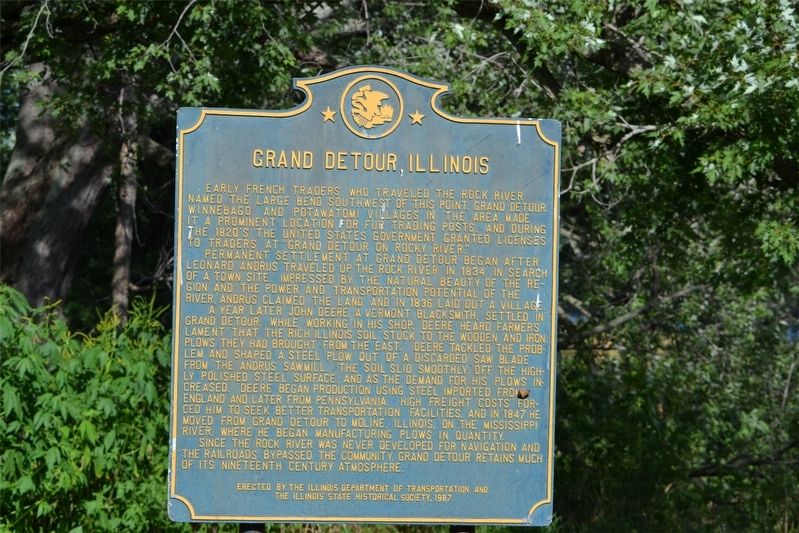Grand Detour, Illinois
Permanent settlement at Grand Detour began after Leonard Andrus traveled up the Rock River in 1834 in search of a town site. Impressed by the natural beauty of the region and the power and transportation potential of the river, Andrus claimed the land and in 1836 laid out a village.
A year later John Deere, a Vermont Blacksmith, settled in Grand Detour. While working in his shop, Deere heard farmers lament that the rich Illinois soil stuck to the wooden and iron plows they had brought from the east. Deere tackled the problem and shaped a steel plow out of a discarded saw blade from the Andrus sawmill. The soil slid smoothly off the highly polished steel surface, and as the demand for his plows increased, Deere began production using steel imported from England and later from Pennsylvania. High freight costs forced him to seek better transportation facilities, and in 1847 he moved from Grand Detour to Moline, Illinois, on the Mississippi River, where he began manufacturing plows in quantity.
Since the Rock
River was never developed for navigation and the railroads bypassed the community, Grand Detour retains much of its nineteenth century atmosphere.Erected 1987 by Illinois Department of Transportation and The Illinois State Historical Society.
Topics. This historical marker is listed in these topic lists: Agriculture • Industry & Commerce • Native Americans • Settlements & Settlers. A significant historical year for this entry is 1834.
Location. 41° 53.773′ N, 89° 24.761′ W. Marker is in Grand Detour, Illinois, in Ogle County. Marker can be reached from Illinois Route 2. Can be viewed from parking lot near the river. Touch for map. Marker is in this post office area: Dixon IL 61021, United States of America. Touch for directions.
Other nearby markers. At least 8 other markers are within 5 miles of this marker, measured as the crow flies. Upper Ferry Landing (within shouting distance of this marker); Erected to the memory of Leonard Andrus founder of the village of Grand Detour Illinois 1835 (within shouting distance of this marker); The Grand Detour Plow Factory (within shouting distance of this marker); John Deere Home and Shop (approx. 0.2 miles away); La Sallier's Cabin (approx. 0.9 miles away); Site of the First Cabin Built for Hon. Joseph Crawford (approx. one mile away); Christopher Brookner House (approx. 4.8 miles away); Lincoln in the Black Hawk War (approx. 5 miles away). Touch for a list and map of all markers in Grand Detour.
Credits. This page was last revised on March 22, 2019. It was originally submitted on March 22, 2019. This page has been viewed 501 times since then and 64 times this year. Photo 1. submitted on March 22, 2019. • Bill Pfingsten was the editor who published this page.
